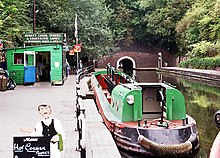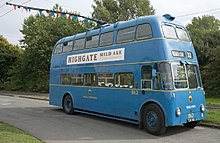Black Country Living Museum
The museum occupies 10.5 hectares (26 acres) of former industrial land partly reclaimed from a former railway goods yard, disused lime kilns, canal arm and former coal pits.The museum opened to the public in 1978, and has since added over 50 shops, houses and other industrial buildings from around the metropolitan boroughs of Dudley, Sandwell and Walsall and the City of Wolverhampton (collectively known as the Black Country); mainly in a specially built village.Most buildings were relocated from their original sites to form a base from where demonstrators portray life spanning 300 years of history, with a focus on 1850–1950.[3] Electric trams and trolleybuses transport visitors from the entrance to the village where thirty domestic and industrial buildings have been relocated close to the canal basin.On 16 February 2012, the museum's collection was awarded designated status by Arts Council England,[4] a mark of distinction celebrating its unique national and international importance.[6] By the main entrance in the old Rolfe Street Baths from Smethwick (1888) are displays of local artefacts encompassing some of the many products which were made by Black Country industry, cast iron hollow ware, animal traps, vehicles, chain, anchors, enamels, weighing scales, laundry irons, nails, locks and fire clay products.[7] In 1712, Thomas Newcomen built the world's first successful steam engine which was used for pumping water from coal mines on Lord Dudley's estates.Rods hang from the outer end of the beam and operate pumps at the bottom of the mine shaft which raise the water to the surface.The steam in the cylinder is condensed by injecting cold water and the vacuum beneath the piston pulls the inner end of the beam down causing the pump to move.Evidence of quarries and underground remains, the canal, and preserved lime kilns are parts of a scheduled ancient monument which has features from the medieval, Industrial Revolution and 20th century.[9] Standing alongside canal arm are the lime kilns, built by the Earl of Dudley to process limestone quarried from Wren's Nest workings.The brass foundry was built in 1869 in Shaw Street, Walsall and closed after the Second World War but re-opened in 1964 by James Powell and used until his death in 1973.The brick tunnel and cart entrance provide access to a late 1930s kitchen with an electric cooker made by Revo[35] of Tipton.There is a radio workshop behind Gripton's[36] and then the stairs lead to two first floor living rooms and two bedrooms which are all set in the late 1930s and furnished with original 1930s style furniture and wall paper.The Cradley Heath Workers' Institute was built with surplus funds raised in 1910 during the strike for a minimum wage by women chain makers.The building contains reconstructed offices, a news room with a digital interpretation of the background to the strike and a large hall which is used for a wide range of activities including theatre performances and concerts.The Resident Fleet is listed below; Wolverhampton was home to some early manufacturers of motor cars, such as Sunbeam, Clyno, AJS and Star.Unusual vehicles in the fleet include a 1924 Guy-Morris fire engine, a Model T Ford van used by Willenhall firm Brevitt's and a Bean of Tipton flatbed truck.The museum has been used as a set for many film and television productions, particularly the first season of Rosie & Jim and the BBC dramas WPC 56[42] and Peaky Blinders.










DudleyCoordinatesOpen-air living museumopen-air museumWest MidlandsBlack CountryBirminghamlime kilnsSandwellWalsallWolverhamptonDud DudleycharcoalIndustrial RevolutionRMS TitanicNewcomen atmospheric engineThomas NewcomenTiptontrolleybusesnarrowboatDudley CanalDudley TunnelArts Council Englandregistered charitySmethwickcast ironhollow warefire claycrystal glassJoseph ChanceOldburythe Racecourse CollieryEarl of DudleyWednesfieldHalesowenrolling millCradley HeathBromwichCradleyOld HillQuarry BankNethertonOliver hammerGregory's General StoreEmile Doo's chemist shoppawnbroker's shopback-to-back housesProvidence ChapelBaker StreetJ W PenfoldCarter's YardCannockCradley Heath Workers' InstituteSecond World WarSt James's SchoolHuddersfieldBilstonThe Cradley Heath Workers' InstituteArts and Crafts styleAlbert Thomas ButlerMary Macarthurfairgroundhelter skelterBirmingham Canal NavigationsNorth Star IIDiamondBessieEustacePresidentKildareBirchillsPeacockWolverhampton District Electric Tramways CompanyDudley, Stourbridge and District Electric Traction CompanyWolverhampton Tramways Companydouble-deckerWolverhampton Corporation TramwaysDaimlerMidland RedGuy MotorstrolleybusWolverhampton Corporation TransportSunbeamBradford Corporation TransportKarrierWalsall Corporation TransportFriskyKingswinfordWearwell Cycle CompanyBritish Motorcycle Charitable TrustMorrisstonewareRosie & JimWPC 56Peaky BlindersStan & OllieLaurel and HardyBlists Hill Victorian TownBeamish MuseumAvoncroft Museum of Historic BuildingsSummerlee Heritage ParkUlster Folk and Transport MuseumSt Fagans National History MuseumSovereign HillTangyestationary engineFellows Morton & Claytonrear (dark green and cream) vehicle is from Derby(light green and yellow) vehicleHarris, Martin & HarrisTipton railway stationDiamond BusMidland MetroCharity Commission for England and WalesHistoric EnglandNational Heritage List for EnglandSt. James' SchoolThe Pawnbrokers ShopThe boat dockLocksmith's HouseNorth StarFlag of the Black Country